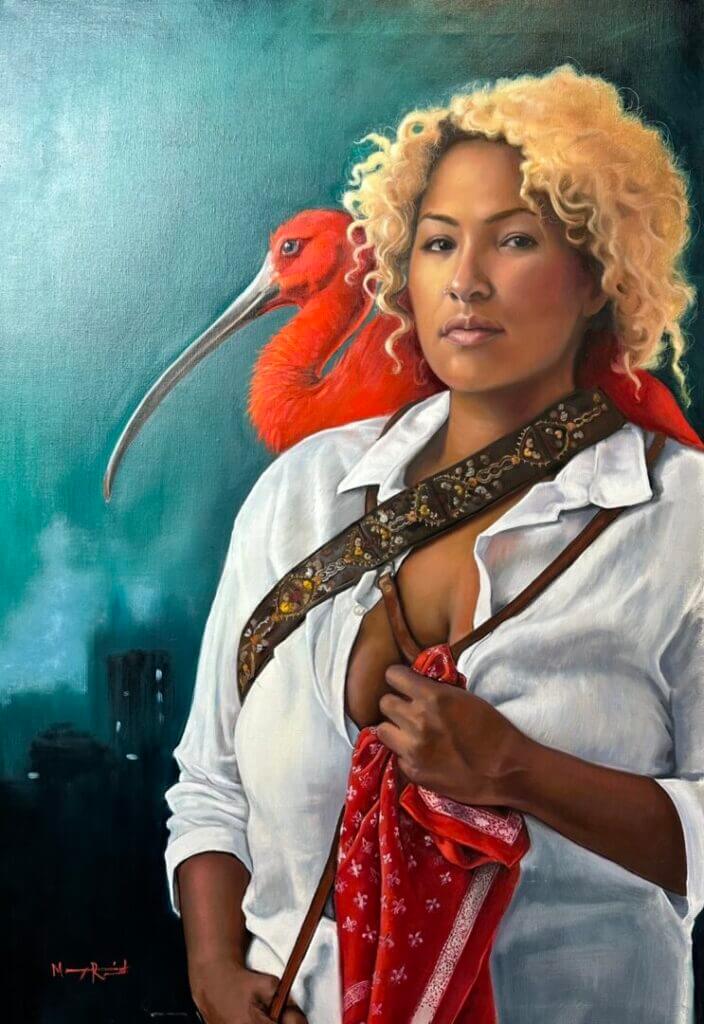Artist Mary Reid with her works “Modesty” and “Romeo and Juliet” photo by Paul Markow
As an editor and writer for Style Lujo, I am excited to share with you the incredible journey and artistry of Mary Reid, an artist whose work seamlessly blends the classical with the modern; an artist whose paintings are a combination of classical realism and her natural inclination for intense color. In a world where art trends are constantly evolving, Mary Reid stands out with her unique approach that captivates and inspires. With art sales reaching record heights last year, generating over $67 billion globally, it’s clear that investing in art is not only a cultural but also a financial boon. In this editorial, we delve into why Mary Reid’s art is not just a feast for the eyes but also a valuable addition to any home or a thoughtful gift.
Inspired by Renaissance artists as well as academic painters and impressionists, Reid’s inspiration is found in Florence, where she embraces the technical aspects of creating art, by way of loose brushstrokes that aim to capture the light. The ardent idea of encompassing an entire story in one image fascinates her, considering the timely quality of our image-driven society. Mary’s desire is to share this passionate feeling through subject and symbolism.
Mary Reid’s paintings are a testament to her profound understanding of storytelling through visual art. Her inspirations stem from the masters of the Renaissance and academic painters, yet she infuses her work with vibrant, intense colors that appeal to contemporary tastes. This perfect blend of classical realism and modern vibrancy makes her pieces versatile and timeless, fitting seamlessly into both traditional and modern interiors.

In recent trends, there’s been a noticeable shift towards incorporating bold, expressive artwork into home decor. Large canvases with dynamic brushstrokes and vivid colors are particularly in vogue, adding personality and depth to living spaces. Mary Reid’s work fits this trend perfectly. Her paintings, which often explore themes of human emotion and symbolism, create focal points that draw the eye and spark conversation.
Adding art to your home is more than just an aesthetic choice; it’s an investment in culture and personal expression. Art has the power to transform a space, making it unique and reflective of the owner’s tastes and values. Whether you’re looking to make a statement in your living room or seeking a meaningful gift for a loved one, a piece by Mary Reid could be the perfect choice. Her paintings not only enhance the visual appeal of a room but also bring a piece of art history into the modern day.
Mary Reid’s presence in the art world is not just about her exceptional talent but also about her ability to connect with viewers on a deeper level. “What artists were doing in the early and high renaissance was innovating technique while paying homage to antiquity and depicting the human form as realistically as possible “in God’s image”. says Reid. “In other words the stories depicted are the same but more humanity is infused into the subjects giving them soft flesh, muscle tone and genitalia as well as human traits like fear, anger and pleasure. This is what I continue to be fascinated by and attempt to emulate.”
Her attention to the nuances of human expression and her commitment to authenticity in her subjects allow her audience to engage in a “sacred conversation” with the artwork. This connection is what makes her pieces so cherished and sought after.
For those interested in adding a unique and timeless piece to their collection, or simply wanting to explore the work of a truly remarkable artist, Mary Reid’s paintings offer an unparalleled opportunity. As we continue to see a growing appreciation for art that bridges the past and present, her work remains at the forefront of this exciting trend.

In the world of contemporary art, few artists manage to blend the classical with the modern as seamlessly as Mary Reid. Her work, influenced by the masters of the Renaissance and academic painters, speaks volumes about her dedication to storytelling, emotional evocation, and the delicate balance between traditional and contemporary techniques. I had the privilege of interviewing artist Mary Reid, delving into her inspirations, techniques, and her unique perspective on art. This insightful interview promises an engaging read that explores the depths of her creative journey.
Personal Journey and Background
Joseph DeAcetis: Could you tell us about your journey as an artist? Where are you from, when did you start painting, and what is your background? How have these elements influenced your artistic path?
Mary Reid: I was born in Palisades Park, New Jersey, just over the George Washington Bridge from New York, but I moved to Arizona as a baby due to my father’s work. Growing up as the youngest of four in an unstable family environment, I became an observer, always trying to read the room and avoid conflict. My mother, the best person I knew, was naturally inquisitive and genuinely interested in everyone she met. Her ability to see the best in every situation and person profoundly influenced me. Although she never created art, she deeply appreciated it and encouraged my interest. This support and my natural inclination eventually led me to pursue an artistic path. However, a negative encounter with a fine arts professor shook my confidence, and I pursued a successful 25-year career as a makeup artist instead. In 2019, I finally heeded my artistic calling and returned to painting.
Inspiration and Artistic Style
Joseph DeAcetis: Your work beautifully blends the influences of Renaissance artists and academic painters. Could you elaborate on how these inspirations shape your combination of classical realism and your natural inclination for vibrant, intense color?
Mary Reid: One aspect of Renaissance art that captivates me is its storytelling. Artists were commissioned to depict biblical stories, religious or political allegories, and lessons from Greek mythology, each infusing their unique perspective into these narratives. For example, although many artists have depicted the Annunciation, the interpretations by Da Vinci, Botticelli, and Caravaggio are distinctly different. Their works allow us to learn the story and gain insights into the artists themselves. Additionally, I sincerely appreciate the discipline of classical realism. Some works, such as Francesco de Rossi’s “Charity,” evoke a visceral emotional response. The exquisite rendering and lifelike depiction make one almost feel the rush of blood to the subject’s cheeks, embodying the artist’s fullest expression.

Experience as a Makeup Artist
Joseph DeAcetis: Having been a professional makeup artist for decades, including work for Forbes and major advertising campaigns, how has this experience influenced your approach to painting? Can you discuss the similarities and differences between applying brushstrokes with makeup versus paint on canvas?
Mary Reid: My career as a makeup artist in commercial advertising and editorial work has been invaluable to my development as a painter. Working with top-tier teams of photographers, stylists, and creative directors taught me the importance of “seeing” with precision. This experience honed my ability to highlight the unique features of each face and recognize the beauty in candid, unguarded moments. Interestingly, I now prefer my painting models to wear little to no makeup, allowing their natural beauty to shine through.
Emotional Evocation and Symbolism

Joseph DeAcetis: How do you evoke emotion and passion through your paintings? Could you provide specific examples of how symbolism plays a role in conveying these feelings?
Mary Reid: I am particularly drawn to the nuances of human expression—the emotions conveyed through the eyes, the tilt of the head, and body language. These elements tell a more compelling story to me than the surrounding details. In my work, I aim for the viewer to connect profoundly, engaging in a “sacred conversation” with the subject or themselves.
Resonance with Modernity
Joseph DeAcetis: In your own words, how do you feel your paintings resonate with today’s race for modernity, and what message do you aim to communicate through this intersection of classicism and contemporary relevance?
Mary Reid: Martin Luther King Jr. once said, “Sometimes, to move forward, we have to go back.” Stripping away contemporary elements reveals our shared humanity. We are all seeking love, meaning, and purpose, striving to be understood. This timeless quest is central to my work. In my “Virtues” series, I depict modern women in vintage attire to explore themes that have resonated throughout history, making it difficult to place my work within a specific period.
Engagement and Interconnectivity
Joseph DeAcetis: How do your paintings engage viewers to reflect and create a sense of interconnectivity with the artwork and its symbolism? What techniques do you use to achieve this?
Mary Reid: I select my models based on their intrinsic qualities rather than societal beauty standards. Understanding my models helps me develop the painting, sometimes altering it. With the rise of AI-generated imagery, it is crucial to remain faithful to the essence of the person I am painting. This authenticity allows viewers to see themselves in the subjects, facilitating a meaningful connection and a “sacred conversation” without distractions.

Technique and Mastery
Joseph DeAcetis: Could you describe your unique and studied approach to using light and brushstrokes? How do these elements contribute to the overall impact and depth of your paintings?
Mary Reid: My work blends the labor-intensive techniques of the old masters with the alla prima method, which emphasizes the effects of color, light, and loose brush strokes. Balancing these methods can be challenging, but it allows me to merge traditional and contemporary techniques in a natural and expressive way.
Art Studies in Italy
Joseph DeAcetis: Could you share insights from your art studies in Italy, including the school you attended, the professors you studied under, and the key lessons you now demonstrate in your work? Was there a specific moment in Italy that ignited a rush of passion and creativity for you?
Mary Reid: Upon deciding to paint again, I enrolled in workshops at Scottsdale Artist’s School, which hosts some of the world’s greatest artists. I have studied with renowned artists such as Johanna Harmon, Romel de la Torre, Rose Frantzen, and many others. I also spend a month each year studying classical realism in Florence, Italy, at The Angel Academy of Art and The Florence Academy of Art. These immersive experiences in Florence and one-on-one sessions with the esteemed American painter Adam Miller have been transformative. Studying in Florence is an all-encompassing experience, with art and inspiration permeating every corner of the city, and the relationships formed with fellow artists are as valuable as formal education.
Gallery Exhibitions and Audience Reception

Joseph DeAcetis: Which galleries have showcased your artwork, and how did the audience perceive it? What feedback have you found most valuable and inspiring?
Mary Reid: In the past year and a half, my work has been featured in two major gallery shows, Cerebral and Chroma: The Property of Light, both presented by Debbie Dickinson Gallery and the Portland on the Park exhibit in Phoenix, Arizona. When I started painting in 2018, I never imagined my work would be showcased in such prestigious settings.
Future Goals
Joseph DeAcetis: Who is your most cherished painter and why? What is the best aspect of painting for you? Looking ahead, what is your business plan and strategy to move forward as a distinguished American painter? What do you want to be known for in the art world?
Mary Reid: I hold deep admiration for many artists, each for their unique contributions, but Joaquin Sorolla consistently leaves me in awe. His ability to convey profound emotion and atmosphere with just a few masterful brushstrokes, combined with his unparalleled command of light and temperature, is truly remarkable. Looking ahead, I am committed to continuous learning. I will continue my studies in Florence this October 2024, and plan my next series. My expertise lies in portraiture, and my ultimate dream is to be someday the official portrait painter of our next President of the United States.
In closing, Mary Reid’s masterpieces are more than just paintings; they are an experience, a dialogue between the past and present, and a celebration of human emotion and artistic excellence. Investing in her art is not just about owning a beautiful object, but about bringing a piece of timeless beauty and profound storytelling into your home.
About the Author:
Joseph DeAcetis is a visionary in the world of fashion, renowned as the best wardrobe stylist and art director of his generation. His impressive accolades and unmatched expertise set him apart in the industry. Joseph covers the intersections of style, culture, art, and fashion, with a particular emphasis on the evolving status of menswear.
Throughout his illustrious career, Joseph has penned award-winning columns for top-tier publications such as Esquire, People Magazine, Robb Report, and Playboy. His profound insights and engaging narratives have made him a leading voice in fashion journalism.
Most recently, Joseph served as the creative fashion director for Forbes Media, where he excelled as both a critic and reporter. His extensive body of work highlights the importance of dressing for success and explores how technological advancements are reshaping the fashion industry. Joseph’s authoritative yet approachable voice continues to inspire and influence fashion enthusiasts worldwide.
Comments, questions, or feedback? Email me at jdeacetis@gmail.com.
For more insights and expert commentary on the latest trends in menswear, visit stylelujo.com.
Save Article










